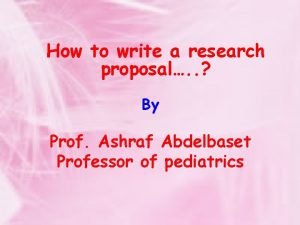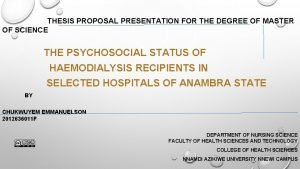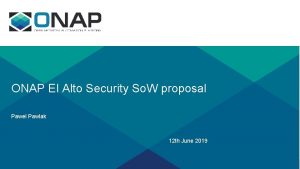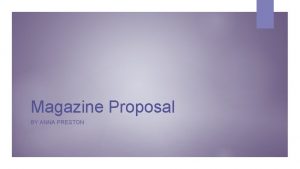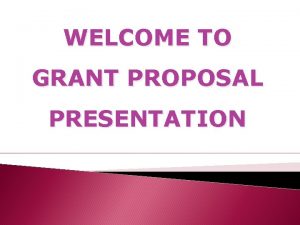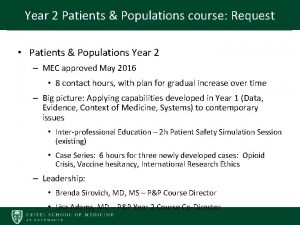Patients Populations Year 2 Proposal A presentation to








- Slides: 8

Patients & Populations Year 2 Proposal A presentation to the Medical Education Committee Brenda Sirovich, MD, MS on behalf of The New Course Faculty Work Group Including Amanda Albright, Pamela Bagley, Alex Grossman, Jon Huntington, Donna Mc. Grath, Carolyn Murray, Cathy Pipas, Judy Rees, Brenda Sirovich, and Craig Westling

Health Molecule Cell Organism Individual Group Healthcare System Population Measurement—Analysis—Critical I n q u i r y — Context Thinking — I n t e g r a t i o n Professionalism—Teamwork—Leadership D e s i g n — Improvement — C h a n g e Communication—Clarity—Listening

PATIENTS & POPULATIONS: IMPROVING HEALTH AND HEALTHCARE Health Molecule Cell Organism Individual Group Healthcare System Population Measurement—Analysis—Critical I n q u i r y — Context Thinking — I n t e g r a t i o n Professionalism—Teamwork—Leadership D e s i g n — Improvement — C h a n g e Communication—Clarity—Listening By the conclusion of the course. . . Ø students will be empowered with the knowledge, capabilities, and motivation Ø to be effective, collaborative problem solvers and change agents Ø who go on to make a difference in the health of both individuals* and populations,

PATIENTS & POPULATIONS: IMPROVING HEALTH AND Incorporates Year 1 Biostats / Epi course as one of 4 intersecting modules HEALTHCARE Further develops content from the Fundamentals of HCDS Seminar course Ø Ø Ø Includes a newly developed module on Professionalism, Teamwork & Leadership Incorporates communication throughout all modules Consists of 60 hours of contact time (19 added) Ø Has taught us a lot Ø Ø YEAR 1 FALL WINTER SPRING Communication OBJECTIVE : TO COMMUNICATE EFFECTIVELY (INCLUDING LISTENING) ABOUT HEALTH & HEALTHCARE Format: Directly incorporated (with assessment) into each module. M e a s u r e. OBJECTIVE m e n: t. T— Analysis—Critical Thinking O DEMONSTRATE KNOWLEDGE, SKILLS, AND AWARENESS TO EFFECTIVELY LEAD CHANGE AT THE INDIVIDUAL, TEAM, AND SYSTEM LEVELS. Leadership y — CMixed o nlarget / esmallxgroup t —(Winter) I n tsessions, e g rsmall a tmentored i o n student teams L e a d. I enr qs hu i ipr Format: Assessment: Readings + structured reflections; individual personal improvement project; participation & professionalism P r o f e s s i oteam n aimprovement l i s m — Tproject; eam work— Leadership OBJECTIVE : DEMONSTRATE AND COLLABORATIVELY APPLY PRINCIPLES AND PRACTICES TO D e s PROCESSES i g n —, OUTCOMES I m p, AND r o. VALUE v e. WITHIN me nt— C h a SYSTEMS n g e IMPROVE & ACROSS HEALTHCARE Systems Communication—Clarity—Listening Systems Format: Mixed large / small group (Winter / Spring) sessions, small inter-professional student teams Assessment: Inter-Professional Shadowing experience + structured reflections; participation & professionalism OBJECTIVE : APPLY STATISTICAL AND EPIDEMIOLOGICAL CONCEPTS, AND MAKE SENSE OF DATA AND EVIDENCE, TO INFORM CLINICAL PRACTICE AND MAKE MEANINGFUL AND MEASURABLE IMPROVEMENT IN HEALTH AND HEALTHCARE. Measurement Format: Series of large group lectures paired with small group discussion and problem solving sessions (Fall); Monthly Canvas Self. Assessments in Biostats/Epi (Winter / Spring) Assessment: 2 Quizzes + cumulative Final Exam (Fall); monthly Self-Assessments (Winter / Spring) OBJECTIVE : EVALUATE THE FORCES, EXPLICIT (E. G. LEGAL, FINANCIAL, REGULATORY) AND IMPLICIT (E. G. HISTORICAL, CULTURAL, ETHICAL), THAT INFLUENCE, AND ANALYZE THE RELATIONSHIP BETWEEN, HEALTHCARE AND POPULATION HEALTH. Context Format: Series of large group interactive sessions (Fall / Winter / Spring). Assessment: Final project short paper submission (Spring) Sept Oct Nov Dec Jan Feb Mar Apr May

PATIENTS & POPULATIONS: IMPROVING HEALTH AND Incorporates Year 1 Biostats / Epi course HEALTHCARE Further develops content from the Fundamentals of HCDS Seminar course Ø Ø Ø Includes a newly developed module on Professionalism, Teamwork & Leadership Incorporates communication throughout all modules Consists of 60 hours of contact time (19 added) Ø Has taught us a lot Ø Ø YEAR 1 The Big Idea: + Nuts & Bolts: need work o Transparency o Order o Other specifics * Measurement—Analysis—Critical I n q u i r y — Context Thinking — I n t e g r a t i o n Professionalism—Teamwork—Leadership D e s i g n — Improvement — C h a n g e Communication—Clarity—Listening Applying the capabilities: The Project

PATIENTS & POPULATIONS: IMPROVING HEALTH AND HEALTHCARE YEAR 2 Why? Objectives Synthesis (As planned) What? Case-based curriculum Project-based curriculum Staged implementation Measurement—Analysis—Critical I n q u i r y — Context Thinking — I n t e g r a t i o n Professionalism—Teamwork—Leadership D e s i g n — Improvement — C h a n g e Communication—Clarity—Listening Applying the capabilities: The Project An elective to start with

PATIENTS & POPULATIONS: IMPROVING HEALTH AND HEALTHCARE YEAR 2 Thank you Questions, Suggestions, Compliments?

Patients & Populations, Year 1 The first year Patients & Populations course consists of 5 overlapping and interwoven modules. Each module corresponds to one of the first 5 (of 6) overarching course learning objectives (see Course Syllabus, p. 2): Measurement (objective #1), Context (#2), Leadership (#3), Systems (#4), and Communication (#5). The following is a schematic concept map of these 5 modules as they will have unfolded over the course of the year. We believe each of these domains is essential for the future physician both in the practice of medicine, and in striving to make a difference on a larger scale, playing a role as effective problem solvers and agents of positive change in healthcare and population health. (The National Board of Medical Examiners also considers these domains important, covering them on the USMLE Step 1, 2, and 3 exams. *) FALL WINTER SPRING Communication OBJECTIVE : TO COMMUNICATE EFFECTIVELY (INCLUDING LISTENING) ABOUT HEALTH & HEALTHCARE Format: Directly incorporated (with assessment) into each module. OBJECTIVE : TO DEMONSTRATE KNOWLEDGE, SKILLS, AND AWARENESS TO EFFECTIVELY LEAD CHANGE AT THE INDIVIDUAL, TEAM, AND SYSTEM LEVELS. Leadership Systems Measurement Format: Mixed large / small group (Winter) sessions, small mentored student teams Assessment: Readings + structured reflections; individual personal improvement project; team improvement project; participation & professionalism OBJECTIVE : DEMONSTRATE AND COLLABORATIVELY APPLY PRINCIPLES AND PRACTICES TO IMPROVE PROCESSES, OUTCOMES, AND VALUE WITHIN & ACROSS HEALTHCARE SYSTEMS Format: Mixed large / small group (Winter / Spring) sessions, small inter-professional student teams Assessment: Inter-Professional Shadowing experience + structured reflections; participation & professionalism OBJECTIVE : APPLY STATISTICAL AND EPIDEMIOLOGICAL CONCEPTS, AND MAKE SENSE OF DATA AND EVIDENCE, TO INFORM CLINICAL PRACTICE AND MAKE MEANINGFUL AND MEASURABLE IMPROVEMENT IN HEALTH AND HEALTHCARE. Format: Series of large group lectures paired with small group discussion and problem solving sessions (Fall); Monthly Canvas Self. Assessments in Biostats/Epi (Winter / Spring) Assessment: 2 Quizzes + cumulative Final Exam (Fall); monthly Self-Assessments (Winter / Spring) Context OBJECTIVE : EVALUATE THE FORCES, EXPLICIT (E. G. LEGAL, FINANCIAL, REGULATORY) AND IMPLICIT (E. G. HISTORICAL, CULTURAL, ETHICAL), THAT INFLUENCE, AND ANALYZE THE RELATIONSHIP BETWEEN, HEALTHCARE AND POPULATION HEALTH. Format: Series of large group interactive sessions (Fall / Winter / Spring). Assessment: Final project short paper submission (Spring) Sept Oct Nov Dec Jan Feb Mar Apr May • See USMLE Content Outline (pp. 29 – 33) and Physician Tasks & Competencies, ‘Required Texts’ Canvas page. (Caveat: We are not exactly big fans of these documents. )
